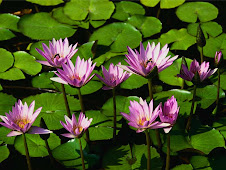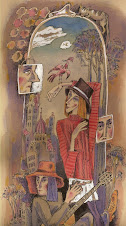July 13, 2010
Dear Sherrie,
These days I've been rededicating myself to less overworking and more understatement. In other words, trying to leave my work fresher, even at the expense of being incomplete. I believe it's an idea that a lot of us could profit by.
We all know the danger of keeping on going--adding detail or complexity when the idea we started out with is well enough expressed without the fiddling. In our innate human desire for perfection we can forget the hand of the artist, even the struggling hand, and the poetic justice of paucity. These elements have value for the second half of the creative partnership--the eyes of the viewer.
Here in Japan it's the principle of "Mujo" (moo-joh). It stems from the ancient Zen concept of transience and uncertainty. A related Japanese word is Mikansei (me-kahn-say-ee) which means "the state of being incomplete." In many ways, the western convention of abstract art fills this bill. In abstraction, you can't always tell exactly what it is you are looking at, and there lies its charm. Mystery builds viewer interest.
The Japanese are not always prepared to go that far. The suggestion of a waterfall or a few cursory brushstrokes indicating a tree or a flower may suffice to communicate a motif.
Here's how to put Mujo to work for yourself: Before starting in with the "busyness" of working, stop to think of the simplest and freshest way a passage might be conceived and executed. Very often a move up to a larger brush, together with a careful mixing of the desired colour, and an elegant, well-contemplated stroke or two can carry the day. Leaving a little primer showing through, or a slight error, a slub or a bump--so what. Even an inadvertent dribble-down or an indecisive painterly scrabble gives life where dullness might otherwise prevail.
We sometimes hear the argument that this sort of incompleteness or roughness only appeals to other artists. I don't think so. I find our world to be loaded and cocked with creator wannabees. We artists represent the last bastion of the hand of man. For others to see art in its freshness, failings and incompleteness may be the greater part of our winning hand.
Best regards,
Robert
PS: "The power of the mujo principle lies in quietly, serenely letting the viewer participate in the representation." (Boye Lafayette De Mente, from his excellent overview "Elements of Japanese Design")
Esoterica: Today I attended a show that included traditional flower arrangement (ikebana). Unlike the western burst of saturated colour and riots of variety--the whole garden in your face--Japanese floral designs tend to be sparse, subtle and simple. A single, tall orchid of an incredible, delicate colour set off by a few dry sticks that twist and struggle alongside, all set, off center, in a delicate and unobtrusive earthen vase. Such is the nature of understatement--an opportunity for the viewer to slow down, take part in, and love.
Assata Shakur Documentary
3 days ago










1 comment:
人生中最好的禮物就是屬於自己的一部份..................................................
Post a Comment